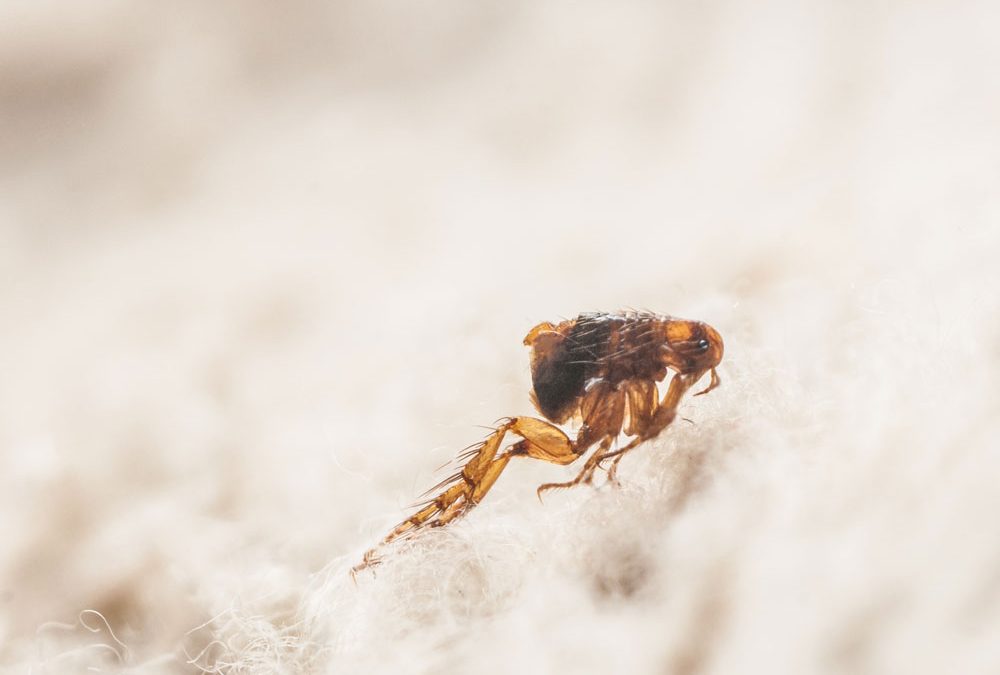It’s much easier to prevent a flea infestation than to get rid of them. Just ask anyone who’s had one.
If you’ve ever had a pet, you’ve probably seen a flea, dead or alive. Fleas survive by feeding on your pet’s blood. They will also feed on your blood in a pinch, and their bites can be itchy and irritating. Even when your pet receives monthly flea prevention, the flea has to bite the dog before the medication will kill it. So if a flea comes in on your pet’s body but hasn’t yet bitten him or her, it can still get into your carpeting or bedding. They can also infest your yard, especially shady spots where your pet might spend his or her time.
There are lots of flea species in the world—about 2,500—with 300 in the U.S. But only three types of fleas can affect human health: the dog flea, cat flea and ground squirrel flea.
Although rare, these three species can transmit typhus and cat-scratch disease, tapeworms, and plague to humans respectively. Interestingly, the dog flea isn’t actually the one you’ll typically find on your dog, cat or pet rat—that’s the cat flea. And the ground squirrel flea is found on—you guessed it—ground squirrels.
A few easy things you can do to help prevent a flea infestation is to regularly vacuum your carpeting, rugs, and furniture cushions. Be sure to empty the vacuum bag after every use. And clean your dog’s bedding frequently with soap and water.
In spite of your best efforts, you still might end of with fleas in your home. If you spot a live flea on your pet, you might already have a flea infestation. If you’re walking through your home and you feel something nipping at your ankles, you almost definitely have an infestation.
To be sure, you’ll need to invest in a magnifying glass. Flea eggs are tiny, off-white ovals that can be hard to see. Give your pet’s bed a thorough once over with your magnifying glass. Also using your magnifying glass, inspect your carpeting closely and be sure to look down between the fibers. If you have hardwoods, look closely at the cracks between the floorboards.
You can also do the “white sock test.” Walk around your house for a few hours wearing a pair of white socks. Chances are, if you have a problem, you’ll see a few fleas clinging to your socks.
If you unfortunately fall victim to a flea infestation, there are four steps to the elimination process, and you need to complete each step carefully:
1) Wash your bedding, your pet’s bedding and any rugs; vacuum carpeting and sweep floors;
2) Bathe your pet with soap and water, and use a flea comb to remove fleas. Be sure to contact your veterinarian to start your pet on flea and tick prevention as soon as possible;
3) Visit your nearest Pestop location to obtain the best products to rid your home of fleas, and use these products simultaneously with your pet’s treatment; and
4) – Re bathe and comb your animal and treat your home two or more times within five to 10 days of the first treatment. Also continue to vacuum and clean bedding, floors and carpeting often during this period.
Pestop has everything you need to prevent or eliminate a flea infestation in your home. For carpeted areas, Pestop offers a granulated powder product, which is less toxic than table salt but kills fleas at the larvae stage. It is guaranteed for a full year after the first seven weeks.
For uncarpeted areas, you can eliminate pre-adult and adult fleas by applying an adulticide containing an insect growth regulator (IGR). Working together, these products will rid your house of egg, larvae and adult stages of the flea.
So be sure to visit your nearest Pestop location for all your pest-control supplies. We have everything you need to keep you and your family safe from these unwanted houseguests.

